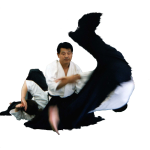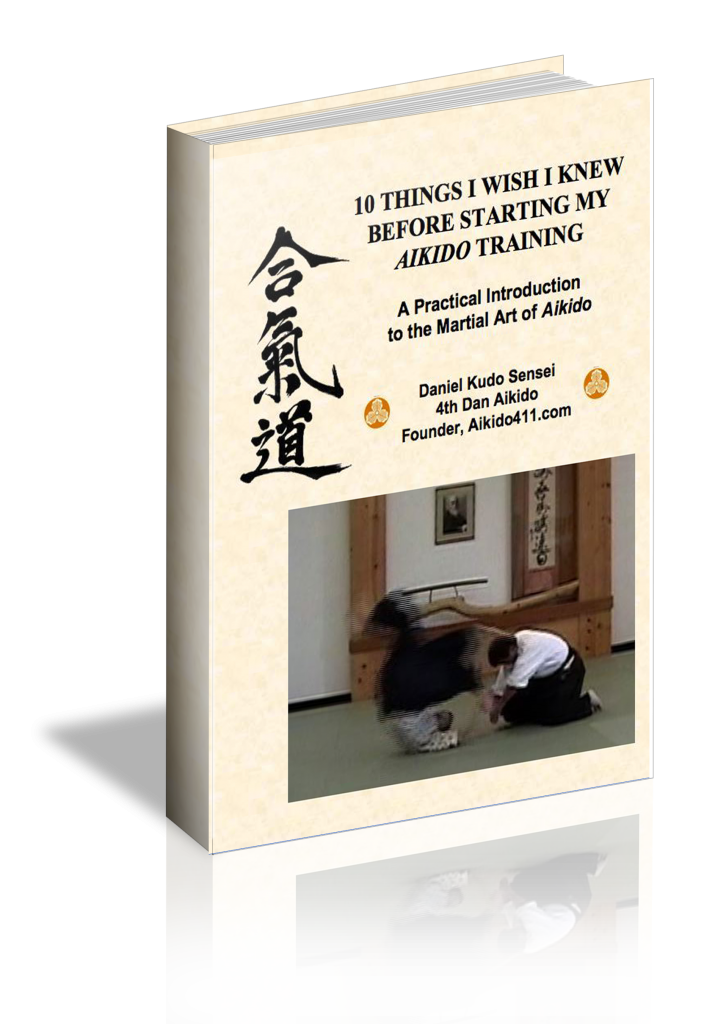Aikido Techniques: Challenging the Mind to Identify and Applying Principles

Aikido Techniques Author: Dan Kudo Sensei
In the following paragraphs I will describe an aspect of Aikido techniques and then ask the reader to recall the concept. At the end of the article I will provide a brief discussion of the concepts covered.
1. As one of the Four Basic Principles of Aikido Techniques, this concept is central to balance and stability. Its focus is on the core or center of gravity and calls for the visualization of this center throughout the technique. In Japanese, this area is referred to as “hara” and it is thought to be the source of power as we apply these techniques. Energy is though to flow from this area and some believe this area may also be where the soul resides.
2. In the article titled “Aikido Techniques: The Fastest Gun Alive”, we read about the fact that a key reasons why many enroll in a martial arts school is to learn self defense. It also describes the various stages of development of a student as he/she progresses through the art. In the conclusion of the article we discover that the best martial art is a personal choice and depends on what key factor?
Aikido Techniques: Ki Flow
3. Another Basic Principle of Aikido techniques involves the flow of an invisible force which can be visualized as water flowing through a fire hose and is the source of power in Aikido techniques. It is thought to originate in the center or hara and is central to the power generated by an Aikido practitioner which transcends upper body strength.
4. An extension of Aikido techniques utilizes the concept of ki extension to promote the body’s ability to heal itself. Ki extension can be described in different ways. The range extends from a low band or spreading form, all the way to a very focused high intensity beam designed to direct a current of ki in a very narrow and deep beam. The concept of this technique is that restoring the flow of ki in an area of injury might renew the flow of ki throughout the body thereby promoting this flow through an injured area.
Aikido Techniques: Finding Answers
Figure out the answers? In the first question, Keep One Point is the concept which describes focusing on the center for balance. The Fastest Gun Alive article addressed the fallacy of trying to “prove” that a certain one martial art is better than the other. Because attempts to prove this point only demonstrate that one artist can defeat another in a given situation with a specific set of rules, the answer to this question is that the best martial art depends on an individual’s goals for taking the art. The third question describes the concept of ki as the source of power which comes from the center. Finally, the Aikido technique of kiatsu is described in question four. It is my hope that this quiz makes you stop and think about these concepts in Aikido techniques.
Click this link to learn more about kiatsu.

Dan Kudo, Im am confused adout the koshinage technique, i have wached your vido on youtube about it and am even more confused. i was wondering if you could clear up a few things for me so i can understand how to do this technique, because i have seen 5 ways to do it. 1. how many ways are thare to do this technique. 2. are the technique you show in your vido diffrent ways of doing the koshinage, or just difrent projections. please e mail me in regards to this.
thanks, Andrew
Andrew – Thank you for commenting on koshinage. Your confusion is understandable. Koshinage is, as you might now have guessed, a multitude of different techniques that involve hip throws. My background was in the martial art of Judo so it’s important to point out to you that there are a huge number of koshinage techniques performed many different ways. Just to name a few there is seoinage, ippon seoinage, and uchi mata. Please review this video to see how uchi mata is performed as a demonstration
http://youtu.be/uYq-_0EQUS4
Now, observe how it is performed in actual competition.
http://youtu.be/R43op-tg-_E
I hope you can see that there is a huge amount of variation even in a single technique but that as you watch different. If you take nothing else away, remember that in all techniques there are huge number of variations. Aikido is no different.
Thank you vary much Sensei Kudo, I now understand that the Koshinage technique can be done different ways to achieve the same end result. I have just started to practice aikido projections. I was mainly confused by this because I thought that there was only one way to do Koshinage like in Ikkyo, Nikyo, Sankyo, Gokyo, Shihonage, and Kotegaeshi when there is a multitude of ways to reach the joint lock that makes one of the above technique, but the objective is to get in to that position to complete the technique.(E.X. Nikyo Z-bar.) so when first looking at diagrams and video of this technique, I began to get confused on it due to the multitude of ways to do it that were all different. My understandings of this technique now are that and please correct me if I am wrong. “That it is any throw that uses the ukes energy to take them down? As you said “A momentum throw.” Is that how you can define the various ways to do Koshinage? is that what it is. I have one more question, when practicing Koshinage should I begin just practicing the ways you show in your video? It would seem to me that those are 3 simple ways to do Koshinage.
I appreciate your righting back,
Thank you vary much, Andrew
in both my comments i have put Koshinage by mistake!!! every time i have said that i have ment kokyunage. kokyunage is the technique i am Confused about, not Koshinage. sorry about that.
Andrew – Take a deep breath and let your mind relax. Like many students, learning Aikido can be confusing because (as you can see) there are so many ways to do certain techniques. Your confusion comes from the fact that, at this point in your training, you tend to see things in a linear or black and white manner. As you continue your Aikido training (which I hope that you will do), you will come to see that there can be many ways in which techniques, particularly kokyunage, can be executed. Just to provide you with a few examples, the following techniques can be considered kokyunage (breath/momentum throws): sumi otoshi (corner drop), irimi nage, sokumen iriminage, and sudori. They could not be more different in the way they look but they all share one thing in common — that is, they utilize momentum as to cornerstone of the energy directed in the throw. The key (ki) to learning Aikido techniques is remember that the mind is like a parachute — when it is open, you float gently to the ground, and when it is close, it doesn’t work at all. When you step of to the mat, let go of any preconceived notions or confusions and completely immerse yourself into training. It will come to you, I promise. Let’s plan to keep this conversation going for twenty year so that I can learn a few things from you!
Sensei Kudo, I thank you very much for responding to my extensive question about Kokyunage. I am glad to say that your explanation of Kokyunage has really helped clear up my confusion. As I now begin to practice Kokyunage I will always keep in mind what you have said, that they are momentum throws. And any movement or technique (such as the ones you have listed) that will lead the ukes ki in “one breath” or that will utilize their momentum to either drop them to the ground or to project them away from you. I appreciate your understanding of my confusion of this technique, as you know exactly how beginners of aikido think when starting this technique. I have practiced Songahm Taekwondo for five years and have become a black belt and a 2008 Massachusetts state weapons champion. As you know various other martial arts such as Karate, Taekwondo, Kung Fu, and many other arts have a set way of doing things. For example a back fist is done one way and that is a back fist. Upon taking up Aikido I found this was much the same for all joint locks (Ikkyo, Nikyo, Sankyo, Gokyo, Shihonage, and Kotegaeshi) all have various ways to get in to them but all end in the same set way that is until reading about Kokyunage and projections and my confusion started. But as I continue to practice this technique as well as other upcoming projections I have yet to learn I will no longer be confused about this. I live in Massachusetts and unfortunately there are few aikido dojos where I live. Your web page here is the only one I could find that I could ask an aikido instructor a question; I thank you very much for creating such a page and find it very helpful in my practice! I hope to learn aikido in addition to my knowledge of Karate and Taekwondo as I am 16 and planning to join the army and hoping to go in the special forces. Upon leaving the army I hope to open my own studio to teach the ways of the martial arts including aikido. Once again I thank you very much for helping me understand Kokyunage and its various aspects. I will definitely post again if I have any other questions about the projections I have yet to learn. To help me as well as others understand this art makes you a true martial artist and I wish you the best in you martial arts career as well as long lasting luck continuing to teach people martial arts and keeping your dojo. I will always carry with me what you have said. I am glad you could be a part of my journey in the ongoing pursuit of perfecting the martial arts and hope to keep in touch.
Thank you very much, Sensei Kudo.
Andrew Weddell
Andrew – You are most welcome. I am glad that I could be of some help to you and look forward to hearing about your continuing journey. It sounds as though you are well grounded in the martial arts already and the arts you spoke of have so much to offer. My eBook will be available soon on the website so click on the page to see what it has to offer. I wish you success and thank you for serving our country. My service began in the US Army and ended in the California Air Guard. One final thought…if you found my thoughts helpful, please find a way to “pay it forward” as you encourage your students as they begin their journey.